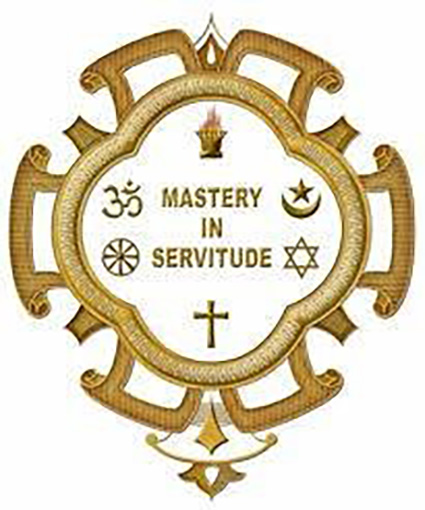ABOUT MEHER BABA
Merwan Sheriar Irani, known around the world as Meher Baba, was born on February 25, 1894, in Poona, India. He was the second son of Shireen and Sheriar Irani, who were both of Persian descent, and followed the Zoroastrian faith.
Young Merwan was a happy child, and led a normal and active life. He attended a Jesuit Catholic high school in Poona, and in 1911 he enrolled in Deccan College, also in Poona. As a student, he enjoyed literature and poetry. Some of his favorite authors were Shakespeare, Shelley and Wordsworth, but he was especially fond of the Sufi poet Hafiz.
While he was at Deccan College he came into contact with Hazrat Babajan, an old Muslim woman. Babajan was one of the five Perfect Masters at the time (a select group of individuals responsible, among other duties, for precipitating the descent of God into human form at the beginning of each Avataric Age). It was in 1913 that she gave Merwan God-realization, awakening him to his divine identity as the Avatar of the Age.
Afterward, Merwan’s consciousness began internalizing the state of God-consciousness. While in the intermediate state, he appeared to his family and friends to have been stricken by a form of madness. During this time he was drawn to the other four Perfect Masters, who helped him to regain normal consciousness, while simultaneously remaining God-conscious.
Merwan Irani embarked upon his spiritual work and public life in 1921, at the age of 25. One of the early members of his circle gave him the name Meher Baba, meaning Compassionate Father. Baba’s disciples were called “mandali” (a Marathi word taken from the Sanskrit “mandal” or “circle”) The mandali came from many different classes and religions, creating a very unusual and challenging environment in a caste-conscious and religiously segregated society such as India.
In 1923, Meher Baba established a small community called Meherabad, near the city of Ahmednagar. This community contained a free school, a free hospital, as well as shelters for the poor. Meherabad is also the location of Baba’s tomb, and has become a place of worldwide pilgrimage.
Throughout his lifetime, Meher Baba permitted male and female disciples to live with him in his Ashram, though the male and female disciples were strictly separated, and mostly hidden from each other. This topic is further explored here.
On July 10, 1925, Meher Baba began observing silence. He remained silent for the remaining 44 years of his life. Initially he dictated his discourses and messages through a slate, later an alphabet board, and still later a unique set of hand gestures that various mandali verbalized.
Meher Baba’s travels took him around the world. He visited England in 1931 and again in 1932. He also traveled six times to the United States and twice to Australia. During his trips, Baba emphasized the need for spiritual redirection, which he explained could only be brought about through the elimination of self-interest. He visited America and Australia in 1952 and 1956, followed by a final visit in 1958, when he and his mandali stayed at the Meher Spiritual Center in Myrtle Beach. He referred to this area as his home in the West. The Myrtle Beach Center still serves as a beautiful spiritual retreat for those who are drawn to Baba.
During his visit to the U.S. in 1952 he suffered the first of two severe automobile accidents. The second accident occurred four years later in India, and resulted in a broken hip, which caused him intense pain for the rest of his life. Baba referred to these accidents as the modern-day equivalent of Christ’s crucifixion.
In 1962 Meher Baba held a mass gathering (“darshan”) for his eastern and western devotees. This was different in size from the darshans he had held for Easterners In India and Europeans, Americans and Australians while on his travels.
In the late 1960s, large numbers of American and Australian youth were becoming interested in Meher Baba. Drug use was becoming increasingly popular at this time, particularly among those professing a spiritual interest in the drug experience. Baba insisted that drugs were damaging physically, mentally and spiritually, and that his followers should refrain from using them. This caused a considerable uproar, and many people lost interest in him. However, this strict position also confirmed many people’s belief in him.
After 1967 Baba remained in deep seclusion and only his closest followers had access to him. Most of this time was spent in complete isolation and was devoted to what he called his “universal work.” Although his health was seriously deteriorating, he scheduled a mass public darshan in 1969. In 1968 he declared that his work was completed one hundred percent to his satisfaction. Because of his injured hip, Baba suffered intense pain during this time.
On January 31, 1969, a few minutes after noon, Baba gestured, “My time has come,” and by 12:15 he was no longer breathing. Meher Baba did not at the time break his silence. Thousands of devotees from the East and the West came to Meher Baba’s tomb before his coffin was sealed. Baba’s tomb has become a place of pilgrimage for his devotees. From April to June 1969, the Great, Last Darshan he had promised took place in Pune, India. Baba had said, “It will be a darshan like no other.”
